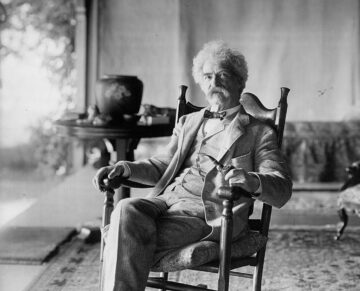Dorian Lynskey in The Guardian:
 “Everybody knows somebody who knows somebody who almost went out with Ted Bundy.”
“Everybody knows somebody who knows somebody who almost went out with Ted Bundy.”
Bundy was one of at least half a dozen serial killers active in Washington in 1974. Within a few years, the state would produce the similarly prolific Randall Woodfield, known as the I-5 Killer, and Gary Ridgway, the Green River Killer. Its murder rate rose by more than 30% in 1974 – almost six times the national average. In Tacoma, the city where Bundy grew up, Ridgway lived and Charles Manson was incarcerated for five years before starting his Family, murder was up 62%. It was as if a malevolent cloud had enveloped the region.
Fraser argues that the epidemic was related to a real cloud, containing sulphur dioxide, arsenic and lead, which emanated from the smokestack of a smelting facility in Ruston, outside Tacoma. Nobody knows what cursed constellation of genes, upbringing, social circumstances, brain chemistry and plain old evil makes serial killers do what they do, but Fraser advances the lead-crime hypothesis. Lead in the blood has been shown to deplete brain volume in the part of the prefrontal cortex that regulates behaviour, especially in men.
More here.
Enjoying the content on 3QD? Help keep us going by donating now.

 Consider this straightforward calculation: (10100) + 1 – (10100)
Consider this straightforward calculation: (10100) + 1 – (10100) In a city well-known for political theater, the show at Stone Nest, a performance venue in the heart of London’s West End, took the concept to a new level. For the last month, audiences have been reenacting the events of Jan. 6, 2021, when a pro-Trump mob stormed the U.S. Capitol in one of the most violent and divisive days of modern American democracy. But instead of sitting in stately silence, legs crammed into velvet chairs, attendees at “Fight for America” were active participants — singing, chanting, rolling dice, and maneuvering tiny figurines around a model of the Capitol.
In a city well-known for political theater, the show at Stone Nest, a performance venue in the heart of London’s West End, took the concept to a new level. For the last month, audiences have been reenacting the events of Jan. 6, 2021, when a pro-Trump mob stormed the U.S. Capitol in one of the most violent and divisive days of modern American democracy. But instead of sitting in stately silence, legs crammed into velvet chairs, attendees at “Fight for America” were active participants — singing, chanting, rolling dice, and maneuvering tiny figurines around a model of the Capitol. Friday is the 30th anniversary of the deadliest massacre in Europe since World War II, when Bosnian Serb forces under Gen. Ratko Mladic overran an area meant to be protected by the United Nations. Soon after, they proceeded to
Friday is the 30th anniversary of the deadliest massacre in Europe since World War II, when Bosnian Serb forces under Gen. Ratko Mladic overran an area meant to be protected by the United Nations. Soon after, they proceeded to  In a 1989 interview with the Detroit Free Press, director Charlotte Zwerin worried that her documentary Thelonious Monk Straight, No Chaser, then newly out in general release after premiering the year before, would be labeled a “jazz film.” Zwerin had grown up, in the 1930s and ’40s, in Detroit, where she had heard a lot of jazz and become a lifelong fan of the music, yet she wanted audiences to see simply that Monk was “an American composer of tremendous stature” who “wrote beautiful songs.” Watching Straight, No Chaser today, you see just what she meant—calling this music jazz (or even American) somehow dilutes the once-in-a-millennium originality of songs that can be heard with the same jolt of immediacy and surprise in all times, places, and genres.
In a 1989 interview with the Detroit Free Press, director Charlotte Zwerin worried that her documentary Thelonious Monk Straight, No Chaser, then newly out in general release after premiering the year before, would be labeled a “jazz film.” Zwerin had grown up, in the 1930s and ’40s, in Detroit, where she had heard a lot of jazz and become a lifelong fan of the music, yet she wanted audiences to see simply that Monk was “an American composer of tremendous stature” who “wrote beautiful songs.” Watching Straight, No Chaser today, you see just what she meant—calling this music jazz (or even American) somehow dilutes the once-in-a-millennium originality of songs that can be heard with the same jolt of immediacy and surprise in all times, places, and genres. 1910: Lahore
1910: Lahore Last night, a friend called to give me the sad news of Naim sahib’s passing. He had not been too well since suffering a stroke a couple of years ago but after returning from rehab his spirit was as indomitable as ever. He relished writing and wrote with zest; sparkling essays, columns and a weekly, later monthly, newsletter that he dispatched electronically to a large following. Naim sahib did not shy away from technology. He had a website on which he posted stuff that he liked. But the newsletter was his commentary on various subjects related to literature, including world politics that impacted literature. He wrote what was on his mind without mincing the truth. It was a privilege to be on his mailing list.
Last night, a friend called to give me the sad news of Naim sahib’s passing. He had not been too well since suffering a stroke a couple of years ago but after returning from rehab his spirit was as indomitable as ever. He relished writing and wrote with zest; sparkling essays, columns and a weekly, later monthly, newsletter that he dispatched electronically to a large following. Naim sahib did not shy away from technology. He had a website on which he posted stuff that he liked. But the newsletter was his commentary on various subjects related to literature, including world politics that impacted literature. He wrote what was on his mind without mincing the truth. It was a privilege to be on his mailing list. During the COVID-19 pandemic, some people took up baking, others decided to get a dog; I chose to grow and observe slime mould. The study in my partner’s flat in Edinburgh became home to two cultures of Physarum polycephalum, an acellular slime mould sometimes more casually referred to as ‘the blob’.
During the COVID-19 pandemic, some people took up baking, others decided to get a dog; I chose to grow and observe slime mould. The study in my partner’s flat in Edinburgh became home to two cultures of Physarum polycephalum, an acellular slime mould sometimes more casually referred to as ‘the blob’. When you accept that other people have secrets, and they will always have secrets, you are preparing yourself for a much more predictable, much more successful future. Because once you accept that reality, you can start applying behaviors, practices into your personal life, into your business life that make it so that you gain more secrets than you share. And gaining secrets in an economy of secrets is the same thing as gaining wealth or gaining power or gaining leverage. You can either live in a world that is not true and believe that people are honest, or you can live in a world that is factual and objective and recognize that all people are keeping secrets from you.
When you accept that other people have secrets, and they will always have secrets, you are preparing yourself for a much more predictable, much more successful future. Because once you accept that reality, you can start applying behaviors, practices into your personal life, into your business life that make it so that you gain more secrets than you share. And gaining secrets in an economy of secrets is the same thing as gaining wealth or gaining power or gaining leverage. You can either live in a world that is not true and believe that people are honest, or you can live in a world that is factual and objective and recognize that all people are keeping secrets from you. The Thinker just discovered, with a mix of awe and quiet dread, that ChatGPT—a machine—could write his latest policy memo better and faster than he could.
The Thinker just discovered, with a mix of awe and quiet dread, that ChatGPT—a machine—could write his latest policy memo better and faster than he could. I was born in the United States and therefore speak American English, because, aside from a brief few years in my childhood when my father assured me that my first language was Mandarin Chinese (my mother’s native tongue), I was raised in an English-speaking household.
I was born in the United States and therefore speak American English, because, aside from a brief few years in my childhood when my father assured me that my first language was Mandarin Chinese (my mother’s native tongue), I was raised in an English-speaking household. How far back must we go to understand the roots of the long enmity between Iran and the United States? A good place to start is the Iran Hostage Crisis, sparked forty-six years ago after the US ally, Shah Mohammad Reza Pahlavi, sought protection and medical care in the US. Iranian revolutionaries took over the US Embassy in Tehran in November 1979 and held sixty-six staffers, demanding the Shah’s return.
How far back must we go to understand the roots of the long enmity between Iran and the United States? A good place to start is the Iran Hostage Crisis, sparked forty-six years ago after the US ally, Shah Mohammad Reza Pahlavi, sought protection and medical care in the US. Iranian revolutionaries took over the US Embassy in Tehran in November 1979 and held sixty-six staffers, demanding the Shah’s return.
 Jimmy Donaldson, the 27-year-old online content creator and entrepreneur known as MrBeast, is by any reasonable metric one of the most popular entertainers on the planet. His
Jimmy Donaldson, the 27-year-old online content creator and entrepreneur known as MrBeast, is by any reasonable metric one of the most popular entertainers on the planet. His